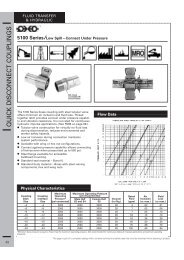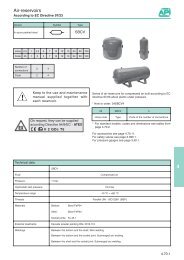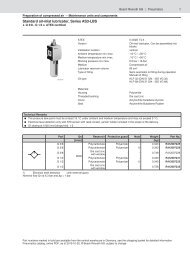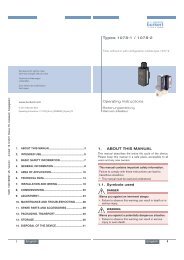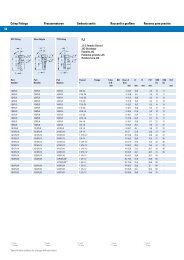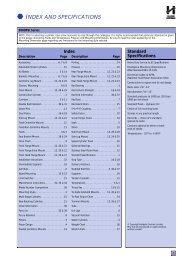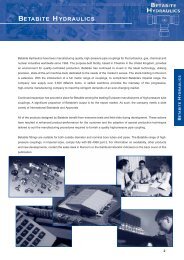Cylinders Short Stroke 16-100mm KPZ Series - Duncan Rogers
Cylinders Short Stroke 16-100mm KPZ Series - Duncan Rogers
Cylinders Short Stroke 16-100mm KPZ Series - Duncan Rogers
You also want an ePaper? Increase the reach of your titles
YUMPU automatically turns print PDFs into web optimized ePapers that Google loves.
increase in net cash income were increases in cash receipts forcrops and livestock of $22.6 billion and $20.3 billion, respectively,an increase in farm-related income of $300 million, offset in partby an increase in cash expenses of $21.7 billion and a decrease indirect government payments of $3.7 billion. Corn prices have risenas a result of a combination of continued food and feed demandand expanding ethanol demand. Other crop prices, in general,were positively impacted by increased acreage used to plant corn,decreasing the amount of acreage available for other crops. Wheatand soybeans compete with corn as a feed source so both wheat andsoybean prices have risen since late 2006. Livestock cash receiptsalso increased as domestic and export demand for beef also rose. Thefollowing table sets forth the commodity prices per bushel for certaincrops and by hundredweight for poultry and milk from December 31,2004 to December 31, 2007:Commodity 12/31/04 12/31/05 12/31/06 12/31/07Corn $ 2.04 $ 1.92 $ 3.01 $ 3.76Soybeans $ 5.45 $ 5.77 $ 6.18 $10.00Wheat $ 3.39 $ 3.54 $ 4.52 $ 7.74Poultry $73.10 $70.38 $69.41 $76.71Milk $<strong>16</strong>.14 $13.37 $13.47 $20.60Rising commodity prices can have both positive and negativeimpacts on the Association, as a lender to the agricultural andrural sectors. Higher commodity prices have resulted in increasedseasonal demand for agribusiness loans. Higher grain pricespositively impact grain farmers. However, higher feed costs maynegatively impact the profitability of livestock producers, as wellas those who use corn or other grains as ingredients in processedfoods. To date, this has not significantly affected the Association’scredit quality. In addition to higher feed costs, most otherproduction cash expenses, such as fertilizer, seed, energy and laborcosts, are forecasted to rise further in 2008.The USDA’s 2007 income outlook showed a great deal of variationdepending on farm size, geographic location and commodityspecialties. We utilized the following USDA analysis to provide a generalunderstanding of the U.S. agricultural economic outlook; however,this outlook does not take into account all aspects of our business.The USDA classifies all farms into three primary categories:commercial farms, intermediate farms and rural residential farms.Commercial farms represent about 11 percent of U.S. farms bynumber and represent 75 percent of total U.S. farm production.Intermediate farms (where the primary occupation is farming andgross sales are below $250,000) represent 26 percent of U.S. farmsby number and account for <strong>16</strong> percent of total production. Theremaining 63 percent of U.S. farms are classified as rural residentialfarms and only account for nine percent of total production.In addition to farmers’ net cash income, off-farm income is animportant source of repayment for farm debt obligations and is lesssubject to cycles in agriculture. The USDA measures farm householdincome, which is defined as earnings from farming activities plusoff-farm income. Nearly 100 percent of farm household income foroperators of rural residential farms and more than 80 percent offarm household income for intermediate farms is generated fromoff-farm sources. Further, USDA data suggests that about 30 percentof farm household income for commercial farms is generated fromoff-farm income. USDA forecasts 2007 farm household incometo increase 21 percent for commercial farms, eight percent forintermediate farms and four percent for rural residential farms.According to the USDA, farm business balance sheets have shownimprovement in the last few years, as measured by debt relativeto assets and equity levels. Farmers’ equity (farm business assetsless farm business debt) is expected to have increased in 2007.One measure of the financial health of the agricultural sectorused by the USDA is the assessment of farmers’ utilization of theircapacity to repay debt (actual debt as a percentage of maximumdebt that can be supported by farmers’ current income). Highercapacity utilization rates indicate tighter cash flow positions and,consequently, higher exposure to financial risk; however, theseestimates do not take into account off-farm income sources. Since1970, debt repayment capacity utilization has ranged from a low of35.8 percent in 1973 to 104.1 percent in 1981, and has remainedrelatively stable since 1987, averaging about 50 percent. USDApredictions suggest a decrease in the use of repayment capacityfrom 57 percent in 2006 to 48 percent in 2007.Farm business debt, defined by the USDA as debt incurred by thoseinvolved in on-farm agricultural production, is estimated to havegrown 3.8 percent in 2007, the fourth consecutive year of risingfarm debt, following a rise of 7.3 percent in 2006. The recent risein debt can be at least partially attributed to farmers’ positiveview of the sector’s future. Farm real estate debt accounted forapproximately 53 percent of all farm debt for 2007 and 2006.In general, agriculture has experienced a long period of favorableeconomic conditions, due to stronger commodity prices, higher landvalues, and, to a lesser extent, government support programs. Todate, the Association’s financial results and credit quality have beenpositively impacted by these conditions. Production agriculture,however, remains a cyclical business that is heavily influencedby commodity prices. In some areas, land values recently havebeen negatively impacted by less favorable economic conditions.Economic conditions in agriculture may not be as favorable inthe future. In an environment of adverse economic conditions inagriculture and without sufficient government support programs,the Association’s financial performance and credit quality measureswould likely be negatively impacted. However, any negative impactsshould be lessened by geographic and commodity diversificationand the substantial influence of off-farm income sources supportingagricultural-related debt.CRITICAL ACCOUNTING POLICIESThe financial statements are reported in conformity with accountingprinciples generally accepted in the United States of America. Oursignificant accounting policies are critical to the understandingof our results of operations and financial position because someaccounting policies require us to make complex or subjectivejudgments and estimates that may affect the value of certain assetsor liabilities. We consider these policies critical because managementMidAtlantic Farm Credit, ACA



